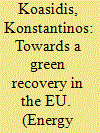| Srl | Item |
| 1 |
ID:
191396


|
|
|
|
|
| Summary/Abstract |
Unprecedented investments in clean energy technology are required for a net-zero carbon energy system before temperatures breach the Paris Agreement goals. By performing a Monte-Carlo Analysis with the detailed ETSAP-TIAM Integrated Assessment Model and by generating 4000 scenarios of the world's energy system, climate and economy, we find that the uncertainty surrounding technology costs, resource potentials, climate sensitivity and the level of decoupling between energy demands and economic growth influence the efficiency of climate policies and accentuate investment risks in clean energy technologies. Contrary to other studies relying on exploring the uncertainty space via model intercomparison, we find that the CO2 emissions and CO2 prices vary convexly and nonlinearly with the discount rate and climate sensitivity over time. Accounting for this uncertainty is important for designing climate policies and carbon prices to accelerate the transition. In 70% of the scenarios, a 1.5 °C temperature overshoot was within this decade, calling for immediate policy action. Delaying this action by ten years may result in 2 °C mitigation costs being similar to those required to reach the 1.5 °C target if started today, with an immediate peak in emissions, a larger uncertainty in the medium-term horizon and a higher effort for net-zero emissions.
|
|
|
|
|
|
|
|
|
|
|
|
|
|
|
|
| 2 |
ID:
187612


|
|
|
|
|
| Summary/Abstract |
To tackle the negative socioeconomic implications of the COVID-19 pandemic, the European Union (EU) introduced the Recovery and Resilience Facility, a financial instrument to help Member States recover, on the basis that minimum 37% of the recovery funds flow towards the green transition. This study contributes to the emerging modelling literature on assessing COVID-19 vis-à-vis decarbonisation efforts, with a particular focus on employment, by optimally allocating the green part of the EU recovery stimulus in selected low-carbon technologies and quantifying the trade-offs between resulting emissions reductions and employment gains in the energy sector. We couple an integrated assessment model with a multi-objective linear-programming model and an uncertainty analysis framework aiming to identify robust portfolio mixes. We find that it is possible to allocate recovery packages to align mitigation goals with both short- and long-term energy-sector employment, although over-emphasising the longer-term sustainability of new energy-sector jobs may be costlier and more vulnerable to uncertainties compared to prioritising environmental and near-term employment gains. Robust portfolios with balanced performance across objectives consistently feature small shares of offshore wind and nuclear investments, while the largest chunks are dominated by onshore wind and biofuels, two technologies with opposite impacts on near- and long-term employment gains.
|
|
|
|
|
|
|
|
|
|
|
|
|
|
|
|